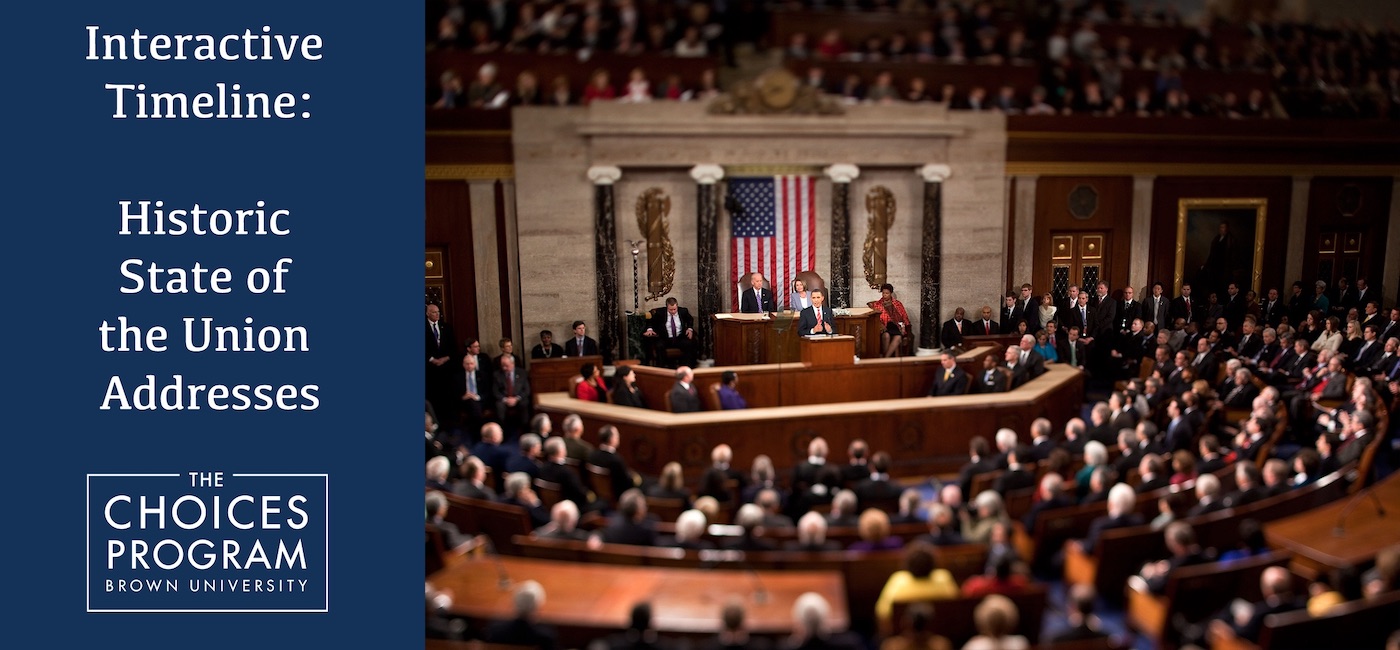Students identify global issues, assess national priorities, and decide for themselves the role the United States should play in the world.
January 2022 (update)
Article II, Section III of the U.S. Constitution says that the U.S. president “…shall from time to time give to the Congress Information of the State of the Union.” This message from the president has evolved to become an annual civic ritual that is full of political theater, but it is also a record of the pressing issues of U.S. history. This lesson allows students to examine the constitutional origins of the address, explore an interactive video timeline of significant moments in twentieth century State of the Union Addresses, and develop the analytical skills and habits of citizenship as they view and assess President Biden’s 2022 State of the Union Address.
Objectives
Students will:
- Understand the constitutional basis and history of the State of the Union Address;
- Explore a video timeline of significant moments in twentieth century State of the Union Addresses and identify important historical themes;
- Collaborate with classmates to identify likely topics for the State of the Union Address;
- Assess President Biden’s 2022 State of the Union Address.
Resources
Interactive Timeline: Historic State of the Union Addresses (above; includes video clips of addresses from 1941 to 2018)
Handout: The State of the Union Address
Graphic Organizer: Historic Addresses
Graphic Organizer: President Biden’s Address
Handout: A Letter to the President
In the Classroom
Note: These activities require access to the internet.
1. The Origins of the State of the Union Address
Interpreting the Constitution: Distribute the handout “The State of the Union Address” to the class. Ask students to read Article II, Section III silently to themselves and then ask someone to read it aloud to the class. Prompt students to identify words or phrases they do not understand. Have students express Article II, Section III in their own words. How precise is the Constitution about how often the president needs to report on the state of union?
2. Historic State of the Union Addresses
Break the class into groups of two or three. (The activity can also be done as a whole class or as a homework assignment.) Distribute the graphic organizer “Historic Addresses” to each student. Direct students to the interactive timeline. Depending on time available, assign each group a few or all of the presidential speeches and have them fill in the graphic organizer. Tell students to look for the “recommended viewing” time period at the end of each video description. (Students viewing President Nixon’s Address have two short clips to watch.)
Have the groups report back to the class. Tell students to record information from the other groups’ reports on their graphic organizer.
- What historical events are mentioned?
- Which State of the Union Addresses were optimistic? Which were pessimistic?
- What were the main issues featured in the video selections?
- Were issues repeated from president to president?
- Do any of the issues mentioned have relevance today?
3. Previewing the President’s Address
Tell students that they will be watching President Biden’s 2022 State of the Union Address.
Distribute the graphic organizer “President Biden’s Address.” Ask the class to brainstorm what students think the president will speak about. What do students think will be the main issue? Have students explain their reasoning. What are the other issues that they believe President Biden will discuss in the address? Have students record their answers on the graphic organizer. Tell students that they will use the graphic organizer when watching the State of the Union. Watch the State of the Union Address as a class or assign it for homework.
4. Making Connections
Have students refer to their graphic organizers and present their findings.
- What topic got the most attention from the president? Why do students think the president focused on this topic?
- Did the president make any historical references?
- Did the president talk about any topics that the class did not anticipate?
- Are there any topics from their list of anticipated topics that the president did not talk about? Why do they think this is so?
- Ask each student to share one point that the president made that they agreed with.
- Ask each student to share one point that they disagreed with.
- What was the main idea or message of President Biden’s speech?
5. Extra Challenge
Distribute the handout “A Letter to the President” to the class. Have students write a letter to the president about some aspect of the State of the Union Address. They can choose to write in support or opposition to a policy or opinion that the president has expressed. They might also choose to note an issue that the president did not mention in the address or include a personal story that relates to a policy issue. Students can mail their letters to the president or email the letters by using the White House website.
Image: Wikicommons, The White House (2010), Public Domain.


